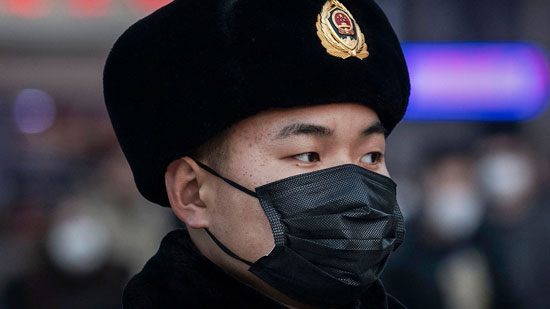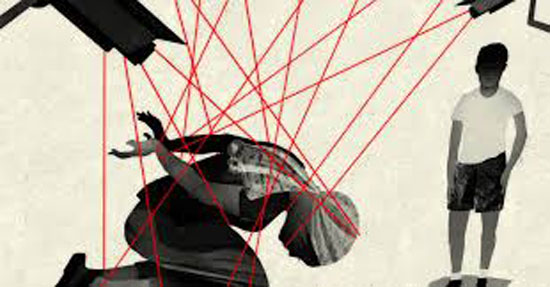Coronavirus Vs. The Mass Surveillance State: Which Poses The Greater Threat?
“If, as it seems, we are in the process
of becoming a totalitarian society in which the state apparatus is all-powerful, the
ethics most important for the survival of the true, free, human individual would be:
cheat, lie, evade, fake it, be elsewhere, forge documents, build improved electronic
gadgets in your garage that’ll outwit the gadgets used by the
authorities.” — Philip K. Dick

Emboldened by the citizenry’s inattention
and willingness to tolerate its abuses, the government has weaponized one national
crisis after another in order to expands its powers.
The war on terror, the war on drugs, the war on
illegal immigration, asset forfeiture schemes, road safety schemes, school safety
schemes, eminent domain: all of these programs started out as legitimate responses
to pressing concerns and have since become weapons of compliance and control in the
police state’s hands.
It doesn’t even matter what the nature of
the crisis might be — civil unrest, the national emergencies,
“unforeseen economic collapse, loss of functioning political and legal
order, purposeful domestic resistance or insurgency, pervasive public health
emergencies, and catastrophic natural and human disasters” — as
long as it allows the government to justify all manner of government tyranny in the
so-called name of national security.
Now we find ourselves on the brink of a possible
coronavirus contagion. I’ll leave the media and the medical community to
speculate about the impact the coronavirus will have on the nation’s health,
but how will the government’s War on the Coronavirus impact our freedoms?
For a hint of what’s in store, you can look
to China — our role model for all things dystopian — where the contagion
started. In an attempt to fight the epidemic, the government has given its
surveillance state apparatus — which boasts the most expansive and
sophisticated surveillance system in the world — free rein. Thermal scanners
using artificial intelligence (AI) have been installed at train stations in major
cities to assess body temperatures and identify anyone with a fever. Facial
recognition cameras and cell phone carriers track people’s movements
constantly, reporting in real time to data centers that can be accessed by
government agents and employers alike. And coded color alerts (red, yellow and
green) sort people into health categories that correspond to the amount of freedom
of movement they’re allowed: “Green code, travel freely. Red or
yellow, report immediately.”
Mind you, prior to the coronavirus outbreak, the
Chinese surveillance state had already been hard at work tracking its citizens
through the use of some 200 million security cameras installed nationwide. Equipped
with facial recognition technology, the cameras allow authorities to track so-called
criminal acts, such as jaywalking, which factor into a person’s social credit
score.
Social media credit scores assigned to Chinese
individuals and businesses categorize them on whether or not they are
“good” citizens. A real-name system — which requires people to use
government-issued ID cards to buy mobile sims, obtain social media accounts, take a
train, board a plane, or even buy groceries — coupled with social media credit
scores ensures that those blacklisted as “unworthy” are banned from
accessing financial markets, buying real estate or travelling by air or train. Among
the activities that can get you labeled unworthy are taking reserved seats on trains
or causing trouble in hospitals.
That same social credit score technology used to
identify, track and segregate citizens is now one of China’s chief weapons in
its fight to contain the coronavirus from spreading. However, it is far from
infallible and a prime example of the difficulties involved in navigating an
autonomous system where disembodied AI systems call the shots. For instance, one
woman, who has no symptoms of the virus but was assigned a red code based on a visit
to her hometown, has been blocked from returning to her home and job until her color
code changes. She has been stuck in this state of limbo for weeks with no means of
challenging the color code or knowing exactly why she’s been assigned a red
code.
Fighting the coronavirus epidemic has given China
the perfect excuse for unleashing the full force of its surveillance and data
collection powers. The problem, as Eamon Barrett acknowledges in Fortune magazine,
is what happens after: “Once the outbreak is controlled, it’s
unclear whether the government will retract its new powers.”
The lesson for the ages: once any government is
allowed to expand its powers, it’s almost impossible to pull back.
Meanwhile, in the U.S., the government thus far
has limited its coronavirus preparations to missives advising the public to stay
calm, wash their hands, and cover their mouths when they cough and sneeze.
Don’t go underestimating the government’s ability to lock the nation
down if the coronavirus turns into a pandemic, however. After all, the government
has been planning and preparing for such a crisis for years now.

The building blocks are already in place for such
an eventuality: the surveillance networks, fusion centers and government contractors
that already share information in real time; the government’s massive
biometric databases that can identify individuals based on genetic and biological
markers; the militarized police, working in conjunction with federal agencies, ready
and able to coordinate with the federal government when it’s time to round up
the targeted individuals; the courts that will sanction the government’s
methods, no matter how unlawful, as long as it’s done in the name of national
security; and the detention facilities, whether private prisons or FEMA internment
camps, that have been built and are waiting to be filled.
Now all of this may sound far-fetched to you now,
but we’ve already arrived at the dystopian futures prophesied by George
Orwell’s 1984, Aldous Huxley’s Brave New World, and
Philip K. Dick’s Minority Report. It won’t take much more to
push us over the edge into Neill Blomkamp’s Elysium, in which the majority of
humanity is relegated to an overpopulated, diseased, warring planet where the
government employs technologies such as drones, tasers and biometric scanners to
track, target and control the populace. Mind you, while these technologies are
already in use today and being hailed for their potentially life-saving, cost-
saving, time-saving benefits, it won’t be long before the drawbacks to having
a government equipped with technology that makes it all-seeing, all-knowing, and
all-powerful — helped along by the citizenry — far outdistance the
benefits.
On a daily basis, Americans are relinquishing (in
many cases, voluntarily) the most intimate details of who we are — their
biological makeup, our genetic blueprints, and our biometrics (facial
characteristics and structure, fingerprints, iris scans, etc.) — in order to
navigate an increasingly technologically-enabled world.
Consider all the ways you continue to be tracked,
hunted, hounded, and stalked by the government and its dubious agents:
– By tapping into your phone lines and cell phone
communications, the government knows what you say. By uploading all of your emails,
opening your mail, and reading your Facebook posts and text messages, the government
knows what you write.
– By monitoring your movements with the use of
license plate readers, surveillance cameras and other tracking devices, the
government knows where you go. By churning through all of the detritus of your life
— what you read, where you go, what you say — the government can predict
what you will do.
– By mapping the synapses in your brain,
scientists — and in turn, the government — will soon know what you
remember. By mapping your biometrics — your “face-print” —
and storing the information in a massive, shared government database available to
bureaucratic agencies, police and the military, the government’s goal is to
use facial recognition software to identify you (and every other person in the
country) and track your movements, wherever you go.
– And by accessing your DNA, the government will
soon know everything else about you that they don’t already know: your family
chart, your ancestry, what you look like, your health history, your inclination to
follow orders or chart your own course, etc.
Of course, none of these technologies are
foolproof. Nor are they immune from tampering, hacking or user bias. Nevertheless,
they have become a convenient tool in the hands of government agents to render null
and void the Constitution’s requirements of privacy and its prohibitions
against unreasonable searches and seizures.
The ramifications of a government — any
government — having this much unregulated, unaccountable power to target,
track, round up and detain its citizens is beyond chilling. Imagine what a
totalitarian regime such as Nazi Germany could have done with this kind of
unadulterated power. Imagine what the next police state to follow in Germany’s
footsteps will do with this kind of power. Society is rapidly moving in that
direction.
We’ve made it so easy for the government to
watch us. Government eyes see your every move: what you read, how much you spend,
where you go, with whom you interact, when you wake up in the morning, what
you’re watching on television and reading on the internet. Every move you make
is being monitored, mined for data, crunched, and tabulated in order to form a
picture of who you are, what makes you tick, and how best to control you when and if
it becomes necessary to bring you in line.

Chances are, as the Washington Post has
reported, you have already been assigned a color-coded threat assessment score
— green, yellow or red — so police are forewarned about your potential
inclination to be a troublemaker depending on whether you’ve had a career in
the military, posted a comment perceived as threatening on Facebook, suffer from a
particular medical condition, or know someone who knows someone who might have
committed a crime. In other words, you’re most likely already flagged in a
government database somewhere.
The government has the know-how. Indeed, for
years now, the FBI and Justice Department have conspired to acquire near-limitless
power and control over biometric information collected on law-abiding individuals,
millions of whom have never been accused of a crime. Going far beyond the scope of
those with criminal backgrounds, the FBI’s Next Generation Identification
database (NGID), a billion dollar boondoggle that is aimed at dramatically expanding
the government’s ID database from a fingerprint system to a vast data
storehouse of iris scans, photos searchable with face recognition technology, palm
prints, and measures of gait and voice recordings alongside records of fingerprints,
scars, and tattoos.
Launched in 2008, the NGID is a massive biometric
database that contains more than 100 million fingerprints and 45 million facial
photos gathered from a variety of sources ranging from criminal suspects and
convicts to daycare workers and visa applicants, including millions of people who
have never committed or even been accused of a crime. In other words, innocent
American citizens are now automatically placed in a suspect database.
For a long time, the government was required to
at least observe some basic restrictions on when, where and how it could access
someone’s biometrics and DNA and use it against them. That is no longer the
case.
The information is being amassed through a
variety of routine procedures, with the police leading the way as prime collectors
of biometrics for something as non-threatening as a simple moving violation. The
nation’s courts are also doing their part to “build” the database,
requiring biometric information as a precursor to more lenient sentences. And of
course Corporate America (including Google, Facebook, Amazon, etc.) has made it so
easy to use one’s biometrics to access everything from bank accounts to cell
phones. We’ve made it so easy for the government to target, identify and track
us.
Add pre-crime programs into the mix with
government agencies and corporations working in tandem to determine who is a
potential danger and spin a sticky spider-web of threat assessments, behavioral
sensing warnings, flagged “words,” and “suspicious” activity
reports using automated eyes and ears, social media, behavior sensing software, and
citizen spies, and you having the makings for a perfect dystopian nightmare. This is
the kind of oppressive pre-crime and pre-thought crime package foreshadowed by
George Orwell, Aldous Huxley and Phillip K. Dick.
Remember, even the most well-intentioned
government law or program can be — and has been — perverted, corrupted
and used to advance illegitimate purposes once profit and power are added to the
equation. In the right (or wrong) hands, benevolent plans can easily be put to
malevolent purposes. Surveillance, digital stalking and the data mining of the
American people add up to a society in which there’s little room for
indiscretions, imperfections, or acts of independence.
This is the creepy, calculating yet diabolical
genius of the American police state: the very technology we hailed as revolutionary
and liberating has become our prison, jailer, probation officer, Big Brother and
Father Knows Best all rolled into one. It turns out that we are Soylent
Green.

The 1973, film of the same name, starring
Charlton Heston and Edward G. Robinson, is set in 2022 in an overpopulated,
polluted, starving New York City whose inhabitants depend on synthetic foods
manufactured by the Soylent Corporation for survival. Heston plays a policeman
investigating a murder, who discovers the grisly truth about the primary ingredient
in the wafer, soylent green, which is the principal source of nourishment for a
starved population.
“It’s people. Soylent Green is
made out of people,” declares Heston’s character.
“They’re making our food out of people. Next thing they’ll be
breeding us like cattle for food.” Oh, how right he was.
Soylent Green is indeed people or, in our case,
Soylent Green is our own personal data, repossessed, repackaged and used by
corporations and the government to entrap us. Without constitutional protections in
place to guard against encroachments on our rights when power, technology and
militaristic governance converge, it won’t be long before we find ourselves,
much like Edward G. Robinson’s character in Soylent Green, looking back on the
past with longing, back to an age where we could speak to whom we wanted, buy what
we wanted, think what we wanted, and go where we wanted without those thoughts,
words and movements being tracked, processed and stored by corporate giants such as
Google, sold to government agencies such as the NSA and CIA, and used against us by
militarized police with their army of futuristic technologies. We’re not quite
there yet. But that moment of reckoning is getting closer by the minute.
In the meantime, we’ve got an epidemic to
survive, so go ahead and wash your hands. Cover your mouth when you cough or sneeze.
And stock up on whatever you might need to survive this virus if it spreads to your
community.
We are indeed at our most vulnerable right now,
but as I make clear in my book Battlefield America: The War on the American
People, it’s the American Surveillance State — not the coronavirus
— that poses the greatest threat to our freedoms.
By John W. Whitehead, constitutional
attorney, the founder and president of The Rutherford Institute.
yogaesoteric
March 26, 2020
